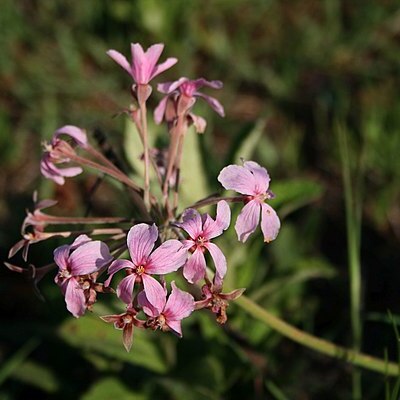Perennial herb, up to 1 m high, with a tuberous, woody rootstock. Leaves radical; petiolate; blade ovate to broadly ovate in outline, 70-150 x 70-140 mm, shallowly lobed to pinnatisect, segments linear, entire to serrate or crenate towards apex, apex acute, variously hairy; petioles 30-200 mm long. Flowers: peduncle with 5-60 flowers in a pseudo-umbel, erect; long, patently hairy; petals 5, narrowly obovate, 12-24 x 5-12 mm, white, yellow, salmon-pink or shades of pink, Sep.-Apr.
A herb. It has a rootstock that lasts from year to year. It grows 70 cm high. The leaves are in a dense ring near the base. New leaves are almost round and later leaves have lobes. The flowering stalk is tall with a large number of flowers. The flowers are white tinged with pink. The leaves on the one plant can vary considerably in size and shape. The lower leaves are less divided. It may be that these plants cross breed or form hybrids.
Geophyte with large, woody tuber, to 80 cm. Leaves variously subdigitately divided, usually sparsely hairy, to ± 30 cm diam. Flowers to 60 on a stout peduncle, 25-40 mm diam., white, pale yellow, or pink; hypanthium 40-80 mm long, much longer than pedicel.


